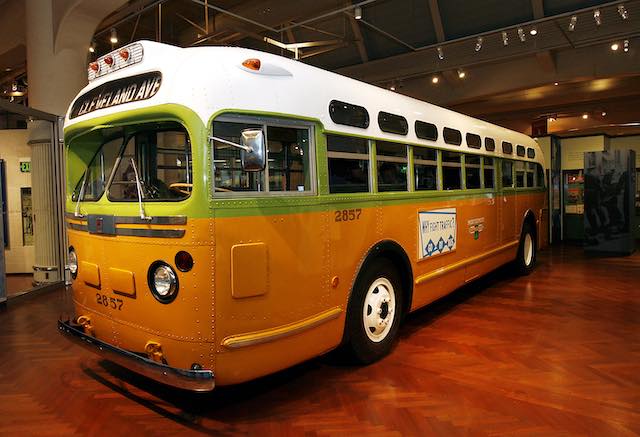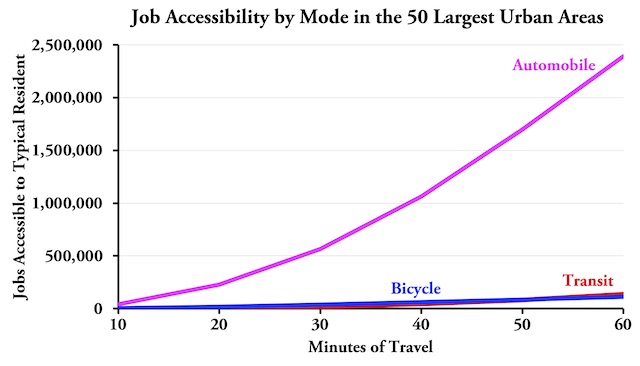“The fight for free transit is about connecting people to opportunity,” proclaims Boston Mayor Michelle Wu. More realistically, the fight for free transit is about keeping poor people oppressed.
The Rosa Parks bus at the Henry Ford Museum in Dearborn, Michigan. Photo by Roderick Eime.
At one time, blacks in the South were expected to ride in the back of transit buses and to yield their seats to whites on demand. Whites at the time probably thought themselves generous that they allowed blacks to ride the buses at all. Today, well-off people such as Wu think they are generous in wishing to use other people’s money to give blacks and other poor people free transit rides.
Wu may not know it, but only 4 percent of workers in 2019 lived in a household that didn’t have a car, and most of them didn’t take transit to work. Only 5 percent of workers who earned under $25,000 a year (and an even smaller share of workers who earned between $25,000 and $35,000) did take transit to work. That number has almost certainly shrunk since the pandemic.
Transit is third-class transportation.
Want to connect people to opportunity? The average resident of U.S. urban areas can reach almost twice as many jobs in a 20-minute auto drive as a 60-minute transit trip. They can also reach more jobs in bike rides of 50 minutes or less than transit trips of the same length. As I told senators at a recent hearing, that makes transit third-class transportation. In offering to use other people’s money to give people free transit rides, Wu is effectively saying, “third-class transportation is good enough for you.”
Who are those other people who will have to subsidize free third-class transportation? More than 75 percent of the taxes used to subsidize transit are regressive, so the people who will be paying are disproportionately low in income, 95 percent of whom don’t ride transit. That’s just one more form of oppression.
The reason some poor people don’t have cars is not the price of a car: in 2019, at least, someone could buy a pretty good used car for $1,000 to $4,000. The problem is that most poor people didn’t have $1,000 to $4,000 in the bank that they could use to buy a used car, and banks typically charge 20 percent to 25 percent interest for used-car loans to people with poor or no credit ratings.
In 2020, transit agencies collected $9 billion in fares, a decline from $16 billion in 2019. Offering free fares would require additional subsidies of at least that much money. Yet that money would go far towards offering every low-income household that doesn’t have a car a low- to no-interest loan to buy a car. If Wu is sincerely interested in connecting people to opportunity, she should propose to spend other people’s money on that rather than on third-class transportation.










You don’t pay taxes, they take taxes…
-Chris Rock
Like someone else mentioned.
If you’re too poor to afford groceries the government will give you a stipend and basically allow you to spent and utilize however you need or see fit. The government doesn’t build its own chain if grocery stores and stock it with its own brand of groceries.
But if you’re too poor to afford a car, government will spend billions to design and build a poorly comprehensive transit most if which is oriented to locations of high tourism volume or job dense regions for people who make 75-100 thousand a year average aka Rich golk…..thevlast people on Earth who fukin need subsidies for transportation.
But transit is viewed as a common public good, hence taxing people is deemed justifiable….even if it’s empty, dilapidated or a colony for bums to piss in.
In the long history of tragedies of the commons…. when a public resource goes to shit…a small but dedicated group of do-gooders assemble to handle load. Central parks conservatory….etc. thats impossible for transit as they don’t know how tobfix the technologies nor are they permitted to tamper with it.
Really gets to be a bit heart breaking to see how lil transit actually serves.
And the response in some circles seems to be invoke equity and spend hundreds of millions on lines out to some burb. But what does that do? Look at Metro Transit’s Purple Line.
They want to spend 1/2 billion to build a bus line out to White Bear Lake. Pre COVID it was project to carry a mere 7,000 riders a day ( aka serve about 3500 people ). The only job centers is serves are downtown STPL and St Johns hospital in Maplewood.
The south end of it, downtown stpl to maplewood mall and the hospital make s a lot of sense. That’s where 90% of the ridership is projected. Make sense, relatively dense and mostly in st. paul.
The part to downtown White Bear Lake is befuddling. It’s ~35 maybe 40% of the cost of the project. There’s nearly no potential for growth as it was built out generations ago. What hasn’t been built on is lake and wetlands.
Proponents invoke taking cars off the road. There’s potential for that on the south end. But around WBL people rarely work downtown. The few that do drive or use a park and ride. This line won’t change that.
Half billion dollars and nearly none of it helps actual people in need get to any living wage jobs. It’d be comical if it wasn’t so sad.